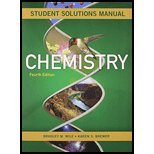
Concept explainers
Interpretation: The balance form of given
Concept introduction: In balanced form of chemical reaction number of atoms and total charge of reactants and products are same.
To determine: The balance form of given chemical reaction occurring in basic solution.
Answer to Problem 10.121AP
The balanced reaction is,
Explanation of Solution
The given unbalanced chemical reaction is,
In balanced form of chemical reaction number of atoms and total charge of reactants and products are same.
To balance the above equation (1) following steps are followed.
Step 1:
Calculate the oxidation state of each atom of given charge compounds.
The oxidation state of oxygen is
The oxidation state of iodine is assumed to be
The oxidation state of
The oxidation state of oxygen is
The oxidation state of sulfur is assumed to be
The oxidation state of
Step 2:
Identify the oxidation and reduction reaction and separate them as half reactions.
In oxidation process, oxidation state of atoms increased by some number.
In reduction process, oxidation state of atoms decreased by some number.
Step 3:
Balance the atoms of reactant and product.
Balance
Balance
Balance
Balance
Step 4:
Balance each half reaction with respect to charge.
Balance the charge of oxidation half reaction by the addition of
Balance the charge of reduction half reaction by the addition of
Step 5:
Make the number of electrons equal on both sides of oxidation and reduction half reaction.
Multiply oxidation half reaction with three on both sides.
Step 6:
To get overall reaction add the half reactions together and remove common terms.
Thus, the balanced reaction is,
The balanced reaction is,
Want to see more full solutions like this?
Chapter 10 Solutions
Student's Solutions Manual: for Chemistry: The Science in Context, Fourth Edition
 ChemistryChemistryISBN:9781305957404Author:Steven S. Zumdahl, Susan A. Zumdahl, Donald J. DeCostePublisher:Cengage Learning
ChemistryChemistryISBN:9781305957404Author:Steven S. Zumdahl, Susan A. Zumdahl, Donald J. DeCostePublisher:Cengage Learning ChemistryChemistryISBN:9781259911156Author:Raymond Chang Dr., Jason Overby ProfessorPublisher:McGraw-Hill Education
ChemistryChemistryISBN:9781259911156Author:Raymond Chang Dr., Jason Overby ProfessorPublisher:McGraw-Hill Education Principles of Instrumental AnalysisChemistryISBN:9781305577213Author:Douglas A. Skoog, F. James Holler, Stanley R. CrouchPublisher:Cengage Learning
Principles of Instrumental AnalysisChemistryISBN:9781305577213Author:Douglas A. Skoog, F. James Holler, Stanley R. CrouchPublisher:Cengage Learning Organic ChemistryChemistryISBN:9780078021558Author:Janice Gorzynski Smith Dr.Publisher:McGraw-Hill Education
Organic ChemistryChemistryISBN:9780078021558Author:Janice Gorzynski Smith Dr.Publisher:McGraw-Hill Education Chemistry: Principles and ReactionsChemistryISBN:9781305079373Author:William L. Masterton, Cecile N. HurleyPublisher:Cengage Learning
Chemistry: Principles and ReactionsChemistryISBN:9781305079373Author:William L. Masterton, Cecile N. HurleyPublisher:Cengage Learning Elementary Principles of Chemical Processes, Bind...ChemistryISBN:9781118431221Author:Richard M. Felder, Ronald W. Rousseau, Lisa G. BullardPublisher:WILEY
Elementary Principles of Chemical Processes, Bind...ChemistryISBN:9781118431221Author:Richard M. Felder, Ronald W. Rousseau, Lisa G. BullardPublisher:WILEY





